The BlackBerry PlayBook Review
by Anand Lal Shimpi on April 13, 2011 9:00 PM EST- Posted in
- Tablets
- Smartphones
- RIM
- BlackBerry
- PlayBook
- Mobile
The Screen
The PlayBook's 7-inch panel has a 1024 x 600 resolution, which for the most part works well for content consumption. Web pages fit nicely, although as I mentioned earlier, in portrait mode you'll need to do a lot of zooming to easily read content. Where the PlayBook's resolution falls flat is when you've got a lot on the screen. Here's what happens when you have a keyboard open in landscape mode on a web page:
In Google docs that leaves you with a single line of text above your keyboard. The same happens elsewhere, although it's less of a problem in Documents To Go.
I've complained in the past about the input problem on tablets, and I do believe it's actually worse on the PlayBook thanks to its cramped screen size. If anything, the PlayBook is even more optimized for content consumption than production of any sort.
Touch sensitivity could also use some work on the PlayBook. While the capacitive touchscreen is normally fine, I've definitely had to double or triple tap to activate controls (particularly small ones) moreso on the PlayBook than on either the iPad or Xoom.
Like Apple, RIM put its focus on the PlayBook's display, which is very bright:
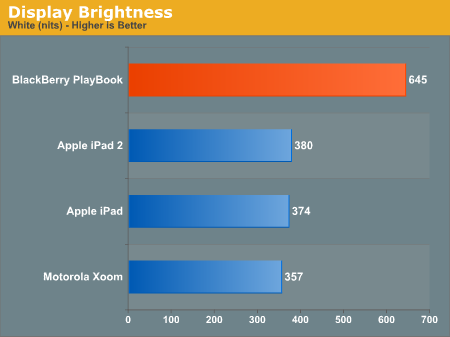
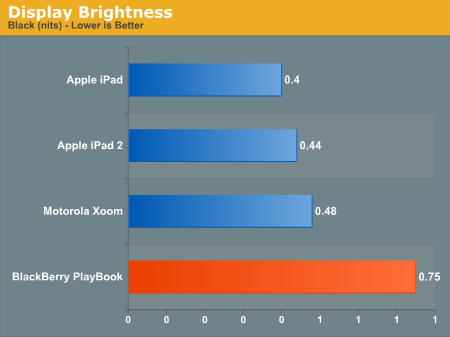

The PlayBook's brightness is high enough that we finally have a tablet that's usable outdoors in direct sunlight:
Viewing angles are also reasonable:


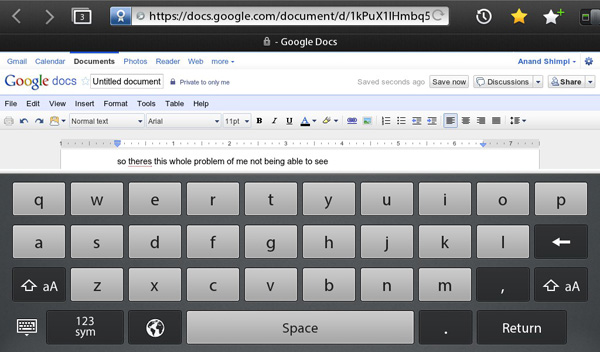
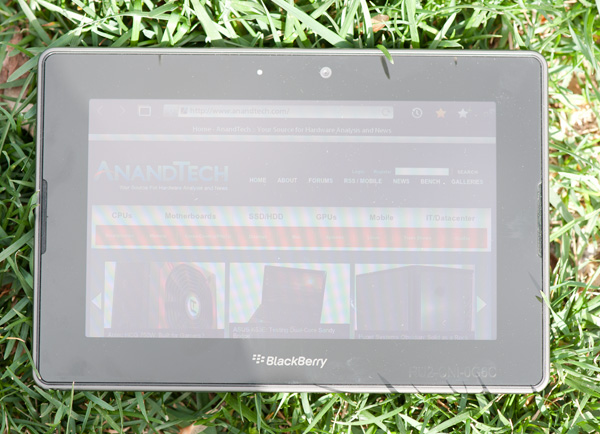
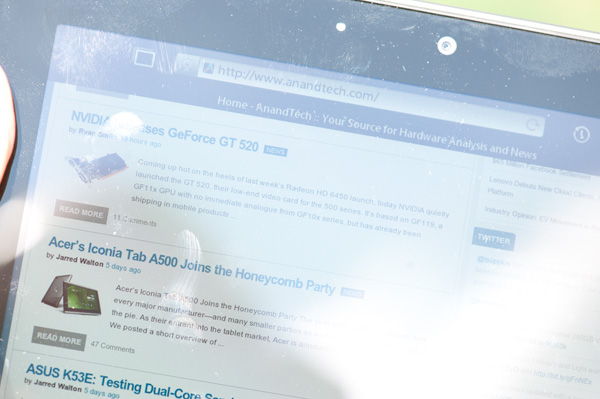
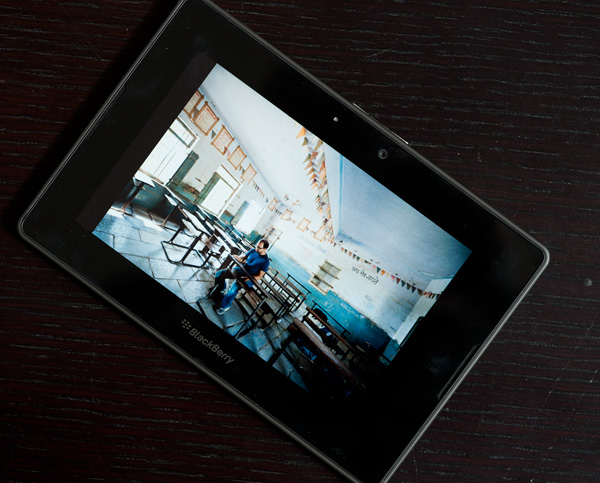
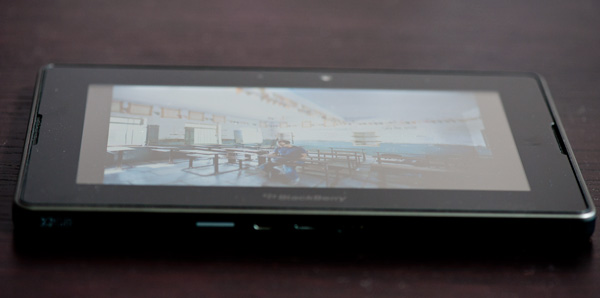
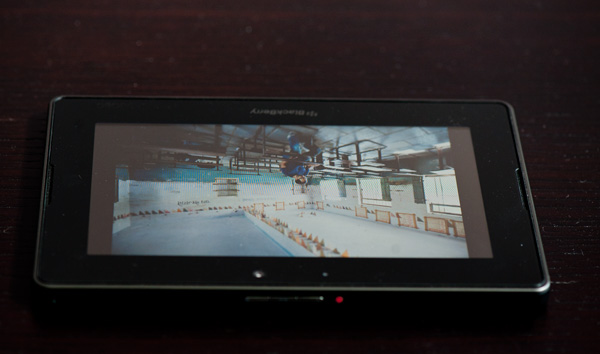








77 Comments
View All Comments
Anand Lal Shimpi - Thursday, April 14, 2011 - link
You're very right, clarified! :)Take care,
Anand
Targon - Thursday, April 14, 2011 - link
I will note that the idea of using gestures that originate in the bezel seems to be an evolution of the Palm(now owned by HP) gesture area on the Palm Pre and the other WebOS based smartphones. Yes, the tablet lets you use any bezel, but as I said, this is an evolution of the concept that Palm implemented with the gesture area.Since the HP Touchpad will not have a dedicated gesture area, it will be interesting to see how things play out going forward in the tablet space.
melgross - Thursday, April 14, 2011 - link
But do the gestures really extend into the bezel area, or do they really just start at the first pixel your finger encounters when swiping from beyond the edge of the screen? I think it's the latter. Swiping from the bezel just insures that your finger will be detected hitting that first pixel in the screen at the edge, which tells the OS that it's a special "bezel" gesture.Maybe I'm wrong, but it makes sense to me that that's how it works, then thinking that the entire bezel is gesture enabled with sensors, though it's possible.
Perhaps Anand, can help here.
AnitaPeterson - Thursday, April 14, 2011 - link
Mate, you wrote so many pages, but eschewed some of the most important questions.1) You discuss the screen, but make no mention of the technology - is it IPS? is it TN? As for the surface - is it polycarbonate? is it GorillaGlass?
2) You discuss the USB, but make no mention of crucial use - does the Playbook have USB host capabilities? In other words, can you connect an external HDD to it (whether self-powered or externally powered) and read files from it?
3) Since we mention USB and external storage, how about a peep about SD card support? Seriously... a review with nary a mention of additional/expandable storage?
4) Why are you comparing it with the iPad and the Xoom, instead of comparing it with the only other real, usable device in its size class, namely the Galaxy Tab??? The Playbook is not for people who want large devices, who can get an iPad... Is it not clear that the size is one of the biggest factors at play here? You mention the Galaxy Tab exactly once, and make an intriguing statement that the Playbook is a bit larger... but when it comes to pictures, again you compare it with the Kindle (!??) and the iPad. Eh? the Kindle???
I'm sorry to be harsh, but this is a rush job... just like the Playbook itself.
Lepton87 - Thursday, April 14, 2011 - link
Have you even read the review? It answers two of your three questions. The tablet doesn't have an SD card slot and it doesn't have an USB port either. Your fist question still stands, I'm also curious what panel technology its screen uses.Pessimism - Thursday, April 14, 2011 - link
Incorrect. It does have a USB port, and the review specifically states this when discussing available charging options. The poster was asking whether its possible to use a male-male USB cable to connect mass storage to it.Pessimism - Thursday, April 14, 2011 - link
of hearing everyone whine and complain about lack of matroska support. matroska has NO STANDING outside anime nuts who can't wrap their brains around a second file to contain subtitles. matroska is a tiny speck with no corporate backing, no manufacturer is going to dedicate development time or die space to support it.Penti - Friday, April 15, 2011 - link
Actually it has pretty good manufacturer standing now, it's supported by Sonic Solutions/divx, ArcSoft, CoreCodec and all the serious chipset manufacturers of media player chipsets and STB solutions. As well as support on BD-players and televisions coming along. Nero also has support for it btw. Even boxes like the Roku now supports local playback and MKV. (Roku XDS with USB) Also there is no die space needed it's just a container. Software is all that's needed. Nokia also added MKV support in Symbian^3.DesktopMan - Thursday, April 14, 2011 - link
"As you'll see in our video tests, the PlayBook is the first ARM based tablet we've used that can decode a 1080p H.264 High Profile video stream."I believe the Hard Kernel ODROID-A was the first on the market (though in limited availability), as it's using the Samsung Exynos 4210 SOC. Would be great to see a test of that, to see how well the Exynos drives a tablet. I have high hopes for it.
NCM - Thursday, April 14, 2011 - link
The ability to handle 1080p H.264 is technically impressive, but I have to wonder about its relevance to the intended business market. One might like that at home, although even there it seems to me to be a party trick.And speaking of business use, the idea of using webmail for that is of course a joke, especially on a mobile device that won't always have a live net connection. I'm sure we all understand that this really is a software timing problem, but still, a bit of an embarrassment for RIM.
I'm not enticed by the 7" screen size, which is too big for the pocket and seems too small for good reading functionality. But one of the things we're seeing from the iPad's success is that people are coming up with their own uses for tablets, uses that weren't necessarily envisioned before they hit the market. Maybe that'll happen with the 7" devices too?